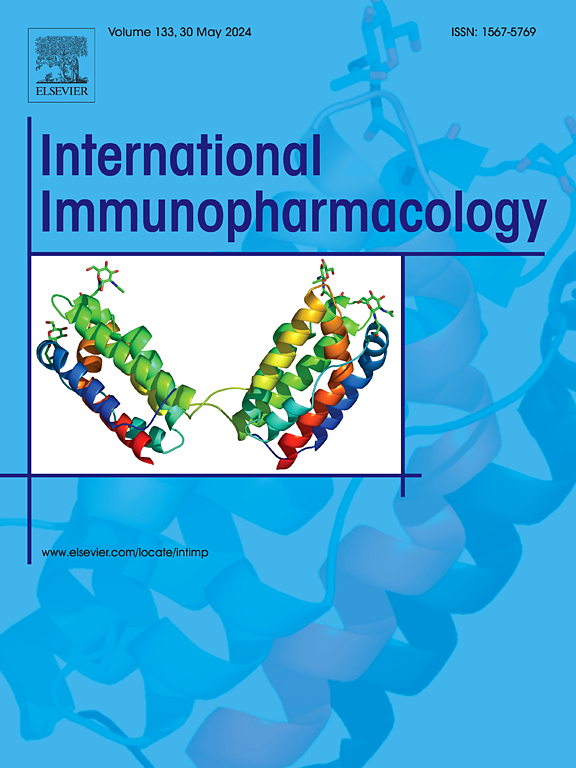Myricetin alleviates DNCB-induced atopic dermatitis by modulating macrophage M1/M2 polarization
IF 4.7
2区 医学
Q2 IMMUNOLOGY
引用次数: 0
Abstract
Background
Atopic dermatitis (AD), a chronic and relapsing inflammatory skin disease, is characterized by recurrent eczema, itch, and pain. Conventional treatments, such as topical corticosteroids, are associated with various adverse effects. Previous studies have shown that Myricetin (Myr) effectively treats AD and inflammation induced by DNFB and MC903. However, the mechanism of Myricetin remains poorly understood. This study aims to investigate the therapeutic effects of Myricetin on DNCB-induced AD and to elucidate the underlying mechanisms.
Methods
An AD model was established with DNCB to evaluate the effectiveness of Myricetin by daily intraperitoneal injection at dosages of 2, 4, and 6 mg/kg. The Enzyme-linked immunosorbent assay (ELISA) was used for measuring levels of inflammatory cytokines/chemokines in ear tissues, Masson's staining was used to assess collagen loss, Immunofluorescence was used to identify macrophage infiltration in skin tissue, and Western blot was employed to detect the expression of proteins associated with M1 and M2 macrophage polarization. To investigate the underlying mechanism in vitro, RAW264.7 cells were employed for macrophage polarization analysis. M1 macrophages phenotype was induced with LPS + IFN-γ, whereas M2 macrophages phenotype was induced by IL-4. The Griess assay method was used to detect the content of NO, and the Enzyme-linked immunosorbent assay (ELISA) was used for measuring levels of IL-6, TNF-α, IL-1β, and IL-10 in M1 macrophage culture medium. Western blot was employed to detect the proteins expression of JAK1, JAK2, STAT1, IκB-α, P65, and iNOS in M1 macrophages. In M2 macrophages, Western blot was employed to detect the proteins expression of JAK1, JAK2, STAT1, STAT6, and Arg-1.
Results
Myricetin ameliorated skin lesions of DNCB-induced AD mice by reduced levels of pro-inflammatory chemokines/cytokines (IL-18, CXCL-9, CXCL-10), attenuated collagen loss in ear lesions, increased levels of the anti-inflammatory factors TGF-β1 and IL-10, increased the number of F4/80/CD206 positive cells and decreased the infiltration of F4/80/CD86 positive cells, suppressed iNOS protein expression and reduced the phosphorylation of STAT1, IκB-α, and P65, while enhancing Arg-1 expression and STAT6 phosphorylation. In vitro studies have demonstrated that Myricetin effectively suppressed the content of inflammatory factors such as IL-6, TNF-α, NO, and IL-1β, while elevating IL-10 concentration, reduced the proteins expression of p-JAK1, p-STAT1 (Tyr701), p-IκB-α, p-P65, and iNOS, in M1 macrophages. In M2 macrophages, Myricetin increased the expression of Arg-1 and phosphorylation of STAT6 protein expression, lowered the expression of phosphorylation of JAK1 protein expression.
Conclusions
Our findings demonstrate that Myricetin significantly ameliorates skin lesions of DNCB-induced AD mice and reduces inflammatory factor levels by inhibiting the STAT1 and NF-κB signaling pathways to prevent M1 macrophage polarization, while activating the STAT6 signaling pathway to promote M2 macrophage polarization.

杨梅素通过调节巨噬细胞M1/M2极化减轻dncb诱导的特应性皮炎
背景:异位性皮炎(AD)是一种慢性复发性炎症性皮肤病,以反复发作的湿疹、瘙痒和疼痛为特征。常规治疗,如局部皮质类固醇,与各种不良反应有关。既往研究表明,Myricetin (Myr)可有效治疗DNFB和MC903诱导的AD和炎症。然而,杨梅素的作用机制尚不清楚。本研究旨在探讨杨梅素对dncb诱导的AD的治疗作用,并探讨其作用机制。方法采用DNCB建立AD模型,评价每日腹腔注射杨梅素2、4、6 mg/kg的疗效。采用酶联免疫吸附法(ELISA)检测耳组织中炎症因子/趋化因子水平,采用Masson染色法评估胶原流失,采用免疫荧光法检测皮肤组织中巨噬细胞浸润,采用Western blot检测巨噬细胞M1和M2极化相关蛋白的表达。为了研究其在体外的潜在机制,我们利用RAW264.7细胞进行巨噬细胞极化分析。LPS + IFN-γ诱导M1巨噬细胞表型,IL-4诱导M2巨噬细胞表型。采用Griess法检测NO含量,ELISA法检测M1巨噬细胞培养液中IL-6、TNF-α、IL-1β、IL-10水平。Western blot检测M1巨噬细胞中JAK1、JAK2、STAT1、i - κ b -α、P65、iNOS等蛋白的表达。在M2巨噬细胞中,Western blot检测JAK1、JAK2、STAT1、STAT6和Arg-1蛋白的表达。结果杨梅素通过降低促炎趋化因子/细胞因子(IL-18、CXCL-9、CXCL-10)水平,减轻耳部胶原损失,提高抗炎因子TGF-β1和IL-10水平,增加F4/80/CD206阳性细胞数量,减少F4/80/CD86阳性细胞的浸润,抑制iNOS蛋白表达,降低STAT1、IκB-α和P65磷酸化,改善dncb诱导AD小鼠皮肤病变。同时增强Arg-1表达和STAT6磷酸化。体外研究表明,杨梅素能有效抑制M1巨噬细胞中IL-6、TNF-α、NO、IL-1β等炎症因子的含量,提高IL-10浓度,降低p-JAK1、p-STAT1 (Tyr701)、p- κ b -α、p-P65、iNOS蛋白的表达。在M2巨噬细胞中,杨梅素增加Arg-1的表达和STAT6蛋白的磷酸化表达,降低JAK1蛋白的磷酸化表达。结论杨梅素通过抑制STAT1和NF-κB信号通路,抑制M1巨噬细胞极化,激活STAT6信号通路,促进M2巨噬细胞极化,显著改善dncb诱导的AD小鼠皮肤病变,降低炎症因子水平。
本文章由计算机程序翻译,如有差异,请以英文原文为准。
求助全文
约1分钟内获得全文
求助全文
来源期刊
CiteScore
8.40
自引率
3.60%
发文量
935
审稿时长
53 days
期刊介绍:
International Immunopharmacology is the primary vehicle for the publication of original research papers pertinent to the overlapping areas of immunology, pharmacology, cytokine biology, immunotherapy, immunopathology and immunotoxicology. Review articles that encompass these subjects are also welcome.
The subject material appropriate for submission includes:
• Clinical studies employing immunotherapy of any type including the use of: bacterial and chemical agents; thymic hormones, interferon, lymphokines, etc., in transplantation and diseases such as cancer, immunodeficiency, chronic infection and allergic, inflammatory or autoimmune disorders.
• Studies on the mechanisms of action of these agents for specific parameters of immune competence as well as the overall clinical state.
• Pre-clinical animal studies and in vitro studies on mechanisms of action with immunopotentiators, immunomodulators, immunoadjuvants and other pharmacological agents active on cells participating in immune or allergic responses.
• Pharmacological compounds, microbial products and toxicological agents that affect the lymphoid system, and their mechanisms of action.
• Agents that activate genes or modify transcription and translation within the immune response.
• Substances activated, generated, or released through immunologic or related pathways that are pharmacologically active.
• Production, function and regulation of cytokines and their receptors.
• Classical pharmacological studies on the effects of chemokines and bioactive factors released during immunological reactions.

 求助内容:
求助内容: 应助结果提醒方式:
应助结果提醒方式:


